八年级下英语第六单元教案
- 格式:doc
- 大小:142.50 KB
- 文档页数:12
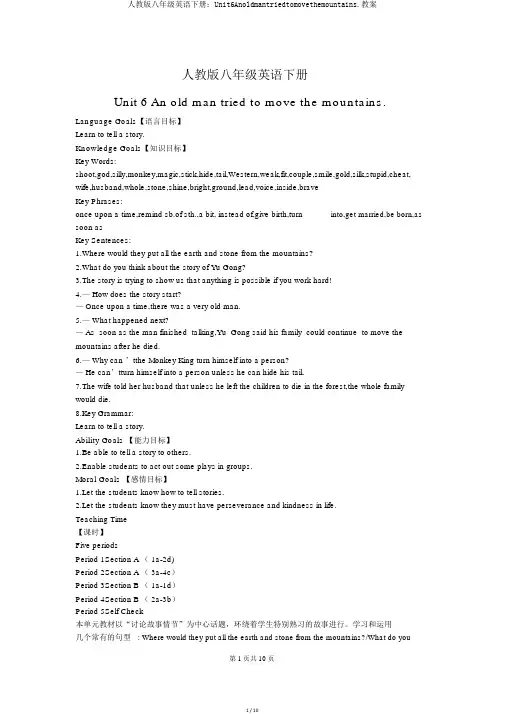
人教版八年级英语下册Unit 6 An old man tried to move the mountains.Language Goals【语言目标】Learn to tell a story.Knowledge Goals【知识目标】Key Words:shoot,god,silly,monkey,magic,stick,hide,tail,Western,weak,fit,couple,smile,gold,silk,stupid,cheat, wife,husband,whole,stone,shine,bright,ground,lead,voice,inside,braveKey Phrases:once upon a time,remind sb.of sth.,a bit, instead of,give birth,turn into,get married,be born,as soon asKey Sentences:1.Where would they put all the earth and stone from the mountains?2.What do you think about the story of Yu Gong?3.The story is trying to show us that anything is possible if you work hard!4.— How does the story start?— Once upon a time,there was a very old man.5.— What happened next?— As soon as the man finished talking,Yu Gong said his family could continue to move themountains after he died.6.— Why can ’tthe Monkey King turn himself into a person?— He can’tturn himself into a person unless he can hide his tail.7.The wife told her husband that unless he left the children to die in the forest,the whole family would die.8.Key Grammar:Learn to tell a story.Ability Goals 【能力目标】1.Be able to tell a story to others.2.Enable students to act out some plays in groups.Moral Goals 【感情目标】1.Let the students know how to tell stories.2.Let the students know they must have perseverance and kindness in life.Teaching Time【课时】Five periodsPeriod 1Section A ( 1a-2d)Period 2Section A ( 3a-4c)Period 3Section B ( 1a-1d)Period 4Section B ( 2a-3b)Period 5Self Check本单元教材以“讨论故事情节”为中心话题,环绕着学生特别熟习的故事进行。
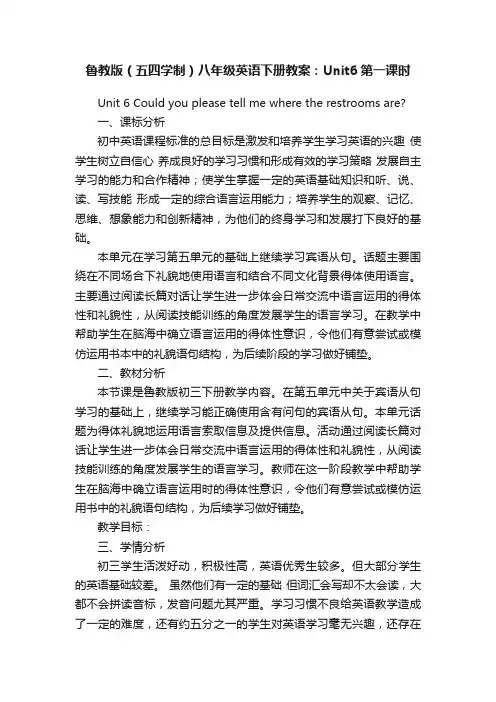
鲁教版(五四学制)八年级英语下册教案:Unit6第一课时Unit 6 Could you please tell me where the restrooms are?一、课标分析初中英语课程标准的总目标是激发和培养学生学习英语的兴趣使学生树立自信心养成良好的学习习惯和形成有效的学习策略发展自主学习的能力和合作精神;使学生掌握一定的英语基础知识和听、说、读、写技能形成一定的综合语言运用能力;培养学生的观察、记忆、思维、想象能力和创新精神,为他们的终身学习和发展打下良好的基础。
本单元在学习第五单元的基础上继续学习宾语从句。
话题主要围绕在不同场合下礼貌地使用语言和结合不同文化背景得体使用语言。
主要通过阅读长篇对话让学生进一步体会日常交流中语言运用的得体性和礼貌性,从阅读技能训练的角度发展学生的语言学习。
在教学中帮助学生在脑海中确立语言运用的得体性意识,令他们有意尝试或模仿运用书本中的礼貌语句结构,为后续阶段的学习做好铺垫。
二、教材分析本节课是鲁教版初三下册教学内容。
在第五单元中关于宾语从句学习的基础上,继续学习能正确使用含有问句的宾语从句。
本单元话题为得体礼貌地运用语言索取信息及提供信息。
活动通过阅读长篇对话让学生进一步体会日常交流中语言运用的得体性和礼貌性,从阅读技能训练的角度发展学生的语言学习。
教师在这一阶段教学中帮助学生在脑海中确立语言运用时的得体性意识,令他们有意尝试或模仿运用书中的礼貌语句结构,为后续学习做好铺垫。
教学目标:三、学情分析初三学生活泼好动,积极性高,英语优秀生较多。
但大部分学生的英语基础较差。
虽然他们有一定的基础但词汇会写却不太会读,大都不会拼读音标,发音问题尤其严重。
学习习惯不良给英语教学造成了一定的难度,还有约五分之一的学生对英语学习毫无兴趣,还存在抵触情绪,给英语教学带来很大的麻烦。
四、教学目标:1. 语言知识目标基本词汇:restroom, stamp, bookstore, postcard, pardon, washroom, bathroom, normal, rush, suggest, staff, grape, central, mail, east, fascinating, convenient, mall, clerk, corner, polite, politely,speaker, request, direction, correct, direct, whom, address, underground基本句型:Excuse me, do you know where I can buy some medicine?Sure. There’s a supermarket down the street.[来源: .Com]Could you please tell me how to get to the post office?Sorry, I’m not sure how to get there.I wonder where we should go next.Could you tell us when the band starts playing this evening?You should try that new ride over there.2. 技能目标: (1)能用宾语从句礼貌的寻求帮助。

Unit 1 Will people have robots ?单元教学目标:1、Words&phrases: robot, paper, less, fewer, simple, unpleasant, factory, seem, etc .2、will 构成的一般将来时态的陈述句、否定句、疑问句及回答.3、There be 句型的一般将来时.4、more , less , fewer 的用法.5、学习一般将来时态的相关知识,学会对未来进行预测.单元重难点:1、will构成一般将来时态的句式。
2、There be 句型的一般将来时态。
3、more , fewer , less 的用法。
4、How to make predictions .第一课时课前准备:教师:录音机、所学物品的图片。
学生:英语点金教练、练习本及相关的学习用具教学步骤:Step 1 Leading in(导入话题,激活背景知识)(导入话题,激活背景知识)1.Greetings: Welcome to school .What’s the date today ? Who’s o n duty today ?Do you enjoy your winter holiday ?(你喜欢你的寒假吗?)Do you finish your Homework(家庭作业)?(你完成你的假期作业了吗?)Do you want to live on the moon ?(你想去月球吗?)Can you guess what will happen in ten years ?(你能猜出十年后将会发生什么吗?)Collect the Ss’ answers and say somethi ng about their predictions .Step 2 Pre-task(任务前活动)SB Page 2 ,1a .1.Look at the picture :How will the world be different in the future ,100 years from now ?We’re going to talk about sth in 100 years .2.Read each predictions to the class .Explain the new vocabulary .3.Read the instructions .Make sure Ss know what they should do .4.Do it by themselves .5.Talk about the answers with the class .Explain :一般将来时态构成: will / be going to +动词原形=Step 3 While-task(任务中活动)SB Page 2 ,1b .1.Practise reading the six predictions .2.Read the instructions to Ss .Circle the things you hear on the recording .3.Play the tape twice .(放录音,两次)4.Play the tape a third time .At the same time ,check the answers .SB Page 2 , 1c .1、Pay attention to the dialogues .2、Read the dialogues fluently .3、Pairwork .Work in pairs to make predictions according to the sample .4、Ask several pairs to share their conversations to the class .SB Page 3 , 2a & 2b .1、Read the predictions .2、Read the instructions and point out the sample answer .3、Play the tape twice .Ss circle the word they hear in each sentences: more , less , fewer .4、Check the answers .学生探究: less , fewer 的区别。
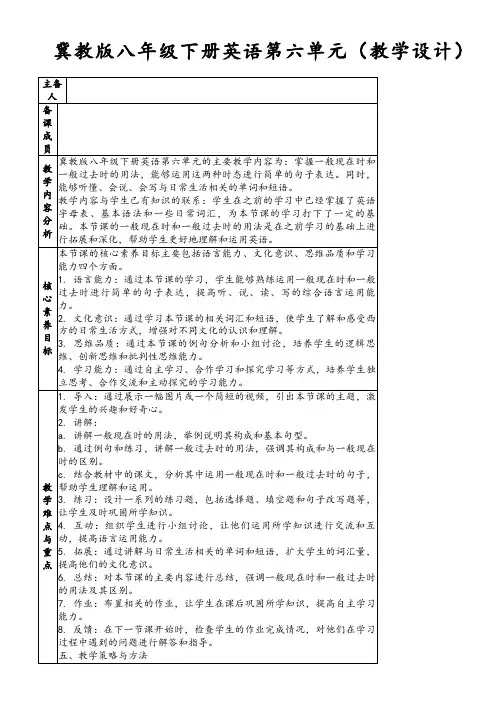

- 1 -- 3 -- 5 -Knowledge aims:1. Words: wife, husband, ground, voice, brave, bright, stepmother, scene2. Phrases: get lost, wake up, make a plan, in the moonlight, shining bright, change the plan, something bad,not… until, be make of, brave enough, plan to do sth.Ability aims: Be able to write a reasonable story ending according to the development of the story.Emotional aims: Reading makes a full man.※教学重难点※Teaching important points: To understand the performance of the western fairy tales, try to use the form of performance or generalization to carry out the language output.Teaching difficult points: The interpretation of the play and the proper use of words.※教学准备※Teaching aids: CAI※教学过程设计※Step 1 Talking1. (2a) Show some fairy tales. Tell Ss a fairy tale is an old, tradi tional story. Do you know what these fairy stories are about? Now discuss them with your partner.2. Ask some Ss say what they know about the fairy stories.e.g. Sleeping Beauty:A lovely princess had to sleep for 100 hundred years because of an evil magic. One hundred years later, ayoung prince came and saved the princes. They got married and had a happy life.Step 2 Reading1. Work on 2b. Tell Ss the following is a fairy tale. It’s name’s Hansel and Gretel.2. Before ReadingAsk Ss to read through the passage and decide what kind of text it is. Is it a letter, a play a short story or so mething else? (Ss may find out that it’s a play.)3. Fast Reading:1) T: Now let’s work on 2b. First, let’s read the questions and make sure we know the meanings of all thequestions. Then read the passage quickly and find the answers to the questions.2) Ss read the letter quickly and try to find the answers to the two questions.3) Check the answers with the class.4. Careful Reading: Work on 2c1) T: Now let’s read the play carefully and try to match each description below with the correct scene.2) Ss read the play care fully and try to match each description.3) Check the answers with the class.5. Post reading: Work on 2d1) Now let’s work on 2d. First read the questions below. Then try to read the play again and find the answersto the questions.2) Ss read the play again and try to find the answers to the questions.3) Let some Ss read their answers and correct their mistakes.4) Ss check their answers with their partners.Step 3 Language points1. One year, the weather was so dry that no food would grow.eg.: That bird’s song is so beautiful that we would follow it.2. We thought you were never coming back.We thought… 表示人们过去的某种想法,判断等,可以译作“我们原想……; 我们本以为……”。
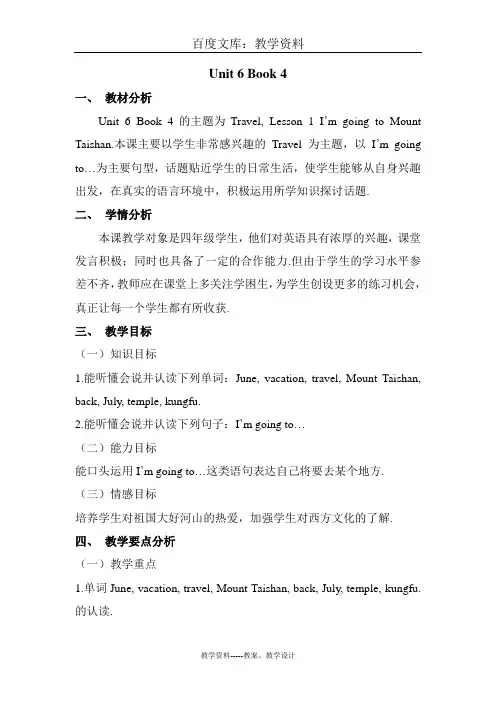
Unit 6 Book 4一、教材分析Unit 6 Book 4的主题为Travel, Lesson 1 I’m going to Mount Taishan.本课主要以学生非常感兴趣的Travel为主题,以I’m going to…为主要句型,话题贴近学生的日常生活,使学生能够从自身兴趣出发,在真实的语言环境中,积极运用所学知识探讨话题.二、学情分析本课教学对象是四年级学生,他们对英语具有浓厚的兴趣,课堂发言积极;同时也具备了一定的合作能力.但由于学生的学习水平参差不齐,教师应在课堂上多关注学困生,为学生创设更多的练习机会,真正让每一个学生都有所收获.三、教学目标(一)知识目标1.能听懂会说并认读下列单词:June, vacation, travel, Mount Taishan, back, July, temple, kungfu.2.能听懂会说并认读下列句子:I’m going to…(二)能力目标能口头运用I’m going to…这类语句表达自己将要去某个地方.(三)情感目标培养学生对祖国大好河山的热爱,加强学生对西方文化的了解.四、教学要点分析(一)教学重点1.单词June, vacation, travel, Mount Taishan, back, July, temple, kungfu.的认读.2.运用I’m going to…等句子描述自己将要去的地方.(二)教学难点能熟练运用所学的单词及句型描述自己自己将要去的地方.五、教学准备单词卡片,相关图片,课件.六、教学过程Step 1 Warming-up1 Greetings.2 Free talk:T: Do you like shopping?S: Yes, I do.T: Do you like traveling?出示单词卡:travel.强调字母a发音,描述发音口型等.再次提问后学生回答:Yes, I do.T: I also like traveling. Now I want to share some beautiful pictures with you.图片出现课文中出现的地方,如:泰山,大连,加拿大,少林寺等,并用英语标注地名.Step 2 Presentation1 Leading-in.T: Our old friends are also talking about these places, now let’s listen and look.白板出示课文课件.2 Text.(1) Listen and look.本次不出示英文.(2) Listen and look again, then pay attention to the names of the places.出示英文.(3) T: Look at the pictures, which is not including?白板出示图片练习:泰山,少林寺,大连,伦敦桥,选择未出现的. T: Now let’s say the words again.白板出示:Mount Taishan, Shaolin Temple.出示单词卡:temple.领读,个读.及其他单词卡:June, July.强调发音/u:/; vacation关注字母a的发音等. 再次利用单词卡巩固单词.(4) Listen and follow.关注学生发音的个别问题,及时纠正.(5) Read the text in groups.(6) Role play.小组表演对话展示.Step 3 Practice1 Fill in the blanks with the new words.I June vacation to travel to the Shaolin Temple. Guoyang is going to Mount Taishan. Tom is going to Dalian. Jenny is going to go back to Canada in July.2 Let’s talk.白板出示图片,教师示范并出示句型.T: Summer vacation is coming.-Where are you going to go?-I’m going to go to Taishan.小组讨论后班级展示.Step 4 Consolidation1 Let’s do.我是小记者:调查本组同学暑假去哪里?白板出示句型:Summer vacation is coming.-Are you going to travel?-Yes, I am.-Where are you going to go?-I’m going to go to Shanghai.小组讨论后展示.2 Pictures show about the cities and countries.白板展示城市:大连,北京,上海,青岛等著名城市,并简单英语描述.及国家:Canada, America, Australia, Britain.并简单英语描述. Step 5 Summary利用板书,让学生对本节课所学习的内容进行总结、归纳,并朗读加深印象,对学生的表现予以肯定和鼓励.Step 6 Assignments1 Listen and follow the tape until you can read it by yourself.2 Think about where will you go on your summer vacation and why.Lesson 2 Unit 6 Book一教学目标(一)知识目标1 能听懂会说并认读下列单词:by, plane, ship, train, bike.2 能听懂会说并认读下列句子:-How are you going to go to the Shaolin Temple?-I’m going to go there by train.(二)能力目标1 能够流利地朗读课文对话并分角色进行表演.2 能在图片或卡片的帮助下运用句型询问并回答如何去某地.(三)情感目标通过课文表演、游戏、小组活动等方式培养学生学习英语的兴趣及积极性.二教学要点分析(一)教学重点1 能正确理解新单词的汉语意思及用法,通过录音跟读培养标准的语音、语调.2 能正确运用句型询问并回答如何去某地.(二)教学难点能正确运用句型询问并回答如何去某地.三教学准备单词卡片,多媒体课件.四教学过程Step 1 Warming-up1 Greetings.2 Free talk:师生自由讨论暑假去哪里?T: Summer vacation is coming. Are you going to travel?S: Yes, I am.T: Where are you going to go?S: I’m going to go to Shanghai.Step 2 Presentation1 Leading-in:T: Can you tell me how are you going to go to Shanghai?白板出示几种交通工具:飞机,轮船,火车,自行车等,并标注英语. T: Today we’ll learn about these things. First let’s listen and look.2 Text:(1) Listen and look.(2) Listen and underline the new words.听录音,划出新单词.出示单词卡,领读并个别检查.(3) Listen and follow.听录音并根据课文内容连线.白板出示人物:Jenny, Tom, Li Ming, Danny.及交通方式:plane, ship, train, bike.将两组连线.(4) Read the text in groups, and then show in the class.Step 3 PracticeT: I’d like to travel, now I wants to show some beautiful pictures to you. 白板展示名胜图片:台湾日月潭,上海东方明珠,北京天安门,泰安泰山,青岛栈桥.T: Maybe it’s far, or near to us, so we can choose different kinds of traffic means. Eg:白板出示交通工具:bike, car, bus, plane, train, ship.教师示范句型后,学生小组讨论并展示.Step 4 Consolidation我是小记者!(每组安排一个同学做小记者,调查其他同学暑假去哪里及怎么去?)Reporter: Where are you going to go?S: I’m going to go to Beijing.R: How are you going to go to Beijing?S: I’m going to go there by plane.小组练习后,请同学做小记者访问其他同学.Step 5 Summary回想本节课所学内容,你学到了哪些?你还有哪些疑问?小组讨论派代表发言.Step 6 Assignments1 Listen and follow the tape.2 Talk about with your friends where are you going to go and how.Lesson 3 Unit 6 Book 4一教学目标(一)知识目标1 能听懂会说并认读下列单词及词组:learn, sunrise, August, sea, boy, girl, have a good time.2 能听懂会说并认读下列句子:-What are you going to do at Shaolin Temple?-I’m going to learn kungfu.(二)能力目标1 能够流利地朗读课文对话并分角色进行表演.2 能在图片或卡片的帮助下运用句型询问并回答去某地做什么. (三)情感目标通过课文表演、游戏、小组活动等方式培养学生学习英语的兴趣及积极性.二教学要点分析(一)教学重点1 能正确理解新单词的汉语意思及用法,通过录音跟读培养标准的语音、语调.2 能正确运用句型询问并回答去某地做什么.(二)教学难点能正确运用句型询问并回答去某地做什么.三教学准备单词卡片,多媒体课件.四教学过程Step 1 Warming-up1 Greetings.2 Free talk:T: These days we’ve talked about many famous places, for example:白板出示地方图片:少林寺,泰山,大连等,并简单介绍这些名胜的闻名之处.T: Who can tell us about other places?请同学来简单讲述自己熟知的风景名胜等.Step 2 Presentation1 Leading-in:T: Now let’s see what our friends are going to do there.2 Text(1) Listen and look.(2) Listen and follow the new words.出示单词卡:learn-learn kungfu, learn English…提示学生出示更多词组.August-June, July.关联词.采用多种方式读单词并个别检查.(3) Listen and follow.并划出课文中的问答句.请学生交流划出的问答句,并结合板书完整重点句型.领读板书并请同学展示读等.(4) Read the text in groups then show in the class.分小组竞争读,选出读的最好的小组,予以鼓励.Step 3 Practice模拟旅游.T: I’ve got some beautiful pictures for you.白板出示风景名胜的图片,并提问:T: Where are you going to go?S: I’m going to go to Yantai.T: What are you going to go there?S: I’m going to swim in the sea.学生选择其中一幅图描述自己将去旅游,同桌提问去做什么,再作答. Step 4 ConsolidationT: Now talk about where and what do you want to, then share with us.(1)Talk about in groups.(2)Show in the class.Step 5 SummaryLet’s copy.认真模仿书写.Step 6 Assignments1 Listen and follow.2 小组依据课文内容编制情景剧,下节课课堂表演.Lesson 4 Unit 6 Book 4六、教材分析Unit 6 Book 4的主题为Travel,本单元主要以学生非常感兴趣的Travel为主题,本节课主要通过学生的对话,小组活动等,将所学内容运用到实际生活中,提高学生运用语言的能力.七、学情分析本课教学对象是四年级学生,对英语学习具有浓厚的兴趣,在学习本课前就已经掌握了一些有关的词汇;并能够进行简单的问答.加之本课内容和我们的日常生活息息相关,因此学生更能够积极地把所学知识运用于实践.八、教学目标(一)知识目标1.复习本单元单词,能听懂会说并认读.2.能听懂会说并认读有关句型.(二)能力目标通过练习学生能学会询问并回答去哪里,如何去,及去做什么等问题.(三)情感目标通过一系列的活动对学生进行情感教育,培养学生热爱祖国大好河山的感情,了解相关的西方文化等.九、教学要点分析(一)教学重点1.本单元单词的认读.2.重点问答句的运用.(二)教学难点通过练习学生学会询问并回答去哪里,如何去,及去做什么等问题.十、教学准备单词卡片,相关图片,小动物头饰,课件.六、教学过程Step 1 Warming-up1 Greetings.2 Free talk:T: Summer vacation is coming. Jenny and Guoyang are talking about the vacation.白板出示图片及句型:Jenny: Summer vacation is coming. I’m going to go back to Canada. Guoyang: I’m going to go to Mount Taishan.J: How are you going to go?G: I’m going to go there by bus.J: What are you going to do there?G: I’m going to see the sunrise.请同学展示情景剧,并予以奖励.Step 2 Presentation1 Leading-in:T: Now Peter is also talking about his vacation with his grandma, let’s listen and look.2 Text(1) Listen and look.(2) Listen and follow.(3) Read by yourselves and show in the class.Step 3 Revision1 Review words.(1) 月份:June, July, August.(2) 交通工具:plane, ship, train, bike.(3) 选词填空:Summer vacation is coming. I’m going to travel to Mount Taishan. I can see the sunrise there! My friend is going to the Shaolin Temple. He wants to learn kungfu there! We will both have a good time!2 Review target language.T: We all like traveling, now, if you have a chance to travel, where are you going to go?白板出示名胜图片,请学生回答:S: I’m going to go to Mount Taishan.T: How are you going to go there?S: I’m going to go there by bus.T: What are you going to do there?S: I’m going to see the sunrise.Step 4 Practice: Make a survey.小组关于即将到来的暑假做调查,记录姓名、去哪里、怎么去、做什么等.-How are you going to go to Dalian?-I’m going to go there by ship.-What are you going to do there?-I’m going to swim in the sea.教师示范对话后,小组练习并展示.Step 5 ConsolidationFun time: Read and enjoy.教师领读后请同学分动物角色表演,小组练习后,分角色朗读表演. Step 6 AssignmentsListen and follow the tape about three times.。

初中英语八年级下册Unit 6 SectionA (1a—1c)教学设计1.教学目标1.知识与技能:让学生学会用英语讲述一个故事。
2.过程与方法:通过复述故事,让学生学会掌握一个故事的细节和人物,并能利用目标语言讲述一个传说或故事。
3.情感、态度与价值观:教育学生在生活中不怕困难,培养他们不言放弃的精神。
2.学情分析1. 八年级的学生积累了一定的词汇量,也学过过去时态,对于本课内容的理解并不难。
但在叙述故事过程中有大量的复杂句,对于长句子的理解、复述和表达成为本课难点。
所以对于部分使用率高的复杂句,利用课件中大量的图片进行练习,让学生掌握扎实。
2. 本班学生两极分化严重,后面的学生基础非常薄弱,且对英语学习兴趣不高,他们在本课学习上会有很大的困难。
所以本课我使用了大量的图片、视频提升学生兴趣,帮助他们首先理解授课内容,反复练习达到基本上口的目标,然后充分发挥思维导图的优势帮助他们学习讲述故事。
小步子,快节奏,低台阶,层次强的授课模式来激发学生的兴趣,增强学习英语的自信,训练能力的提升。
3.重点难点教学重点:学习讲述故事中的人物和相关细节。
教学难点:学习本课时的目标语言,能用自己的语言讲述一个故事。
教学过程第一学时教学活动活动1【导入】创设情景Step1 Warmig up(1)Free talk&enjoy a story named a wolf is coming .1. Do you like stories?2. What kind of stories do you like? (老师可以鼓励学生给出尽可能多的答案)教学设计说明:通过自由讨论故事,欣赏动画故事,承上启下,引出本单元话题。
活动2【讲授】呈现新课Step 2. Presentation(呈现新知识)1.Present the new words :stoone shoot2.Present the name of the story with the picture(教师用同样的方法教授其它故事的名字:1)Journey to the West2)Yu Gong Moves a Mountain3)Hou Yi Shoots the Sun4)Nu Wa Repairs the Sky教学设计说明:教师利用对图片的讨论和问答教授四个故事的名字,形象生动,且能了解故事概要。
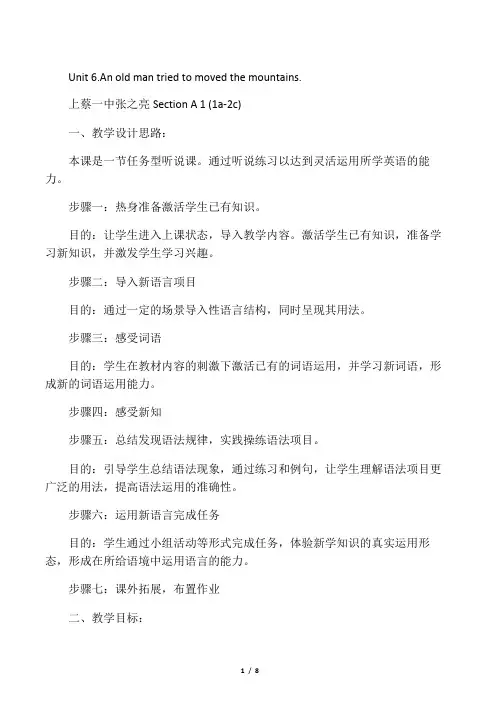
Unit 6.An old man tried to moved the mountains.上蔡一中张之亮Section A 1 (1a-2c)一、教学设计思路:本课是一节任务型听说课。
通过听说练习以达到灵活运用所学英语的能力。
步骤一:热身准备激活学生已有知识。
目的:让学生进入上课状态,导入教学内容。
激活学生已有知识,准备学习新知识,并激发学生学习兴趣。
步骤二:导入新语言项目目的:通过一定的场景导入性语言结构,同时呈现其用法。
步骤三:感受词语目的:学生在教材内容的刺激下激活已有的词语运用,并学习新词语,形成新的词语运用能力。
步骤四:感受新知步骤五:总结发现语法规律,实践操练语法项目。
目的:引导学生总结语法现象,通过练习和例句,让学生理解语法项目更广泛的用法,提高语法运用的准确性。
步骤六:运用新语言完成任务目的:学生通过小组活动等形式完成任务,体验新学知识的真实运用形态,形成在所给语境中运用语言的能力。
步骤七:课外拓展,布置作业二、教学目标:1.语言知识目标:1)能掌握以下单词:shoot, stone, remind能掌握以下句型:① How does the story begin?② What happened next?③ What do you think of the story of Yu Gong?④ What could Yu Gong do if he didn’t move the mountains?2)能够用英语询问故事的开始、发展及后续等。
能够对故事中的人物或情节发表一些简单的看法或观点。
2.情感态度价值观目标:学习愚公,要学习他“顽强拼搏”的精神。
在我们生活工作中存在着很多的“山”。
在这些山的面前我们应该采取怎样的态度对待它?是通过“搬家”来避开它;还是像愚公一样明知困难却迎难而上?凭借自己的力量勇敢地克服困难。
愚公不畏艰险,不怕困难,勇敢面对的精神,正是值得我们所学习的。
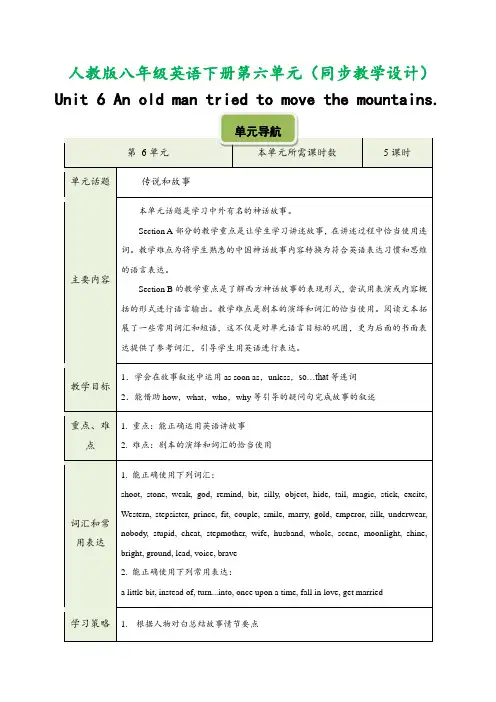
人教版八年级英语下册第六单元(同步教学设计)Unit 6 An old man tried to move the mountains.Unit 6 An old man tried to move the mountains.Unit 6 An old man tried to move the mountains.Unit 6 An old man tried to move the mountains.1.Show a picture of The Emperor’s New Clothes.T: Look at the picture, what’s the story?Ss: The Emperor’s New Clothes.…2. Teach the new words.Step 3 Practice1. Look at 1a. Match the words with the letters in the pictures in 1c.2. Check the answers.Answers: b gold c silk d emperora underwearStep 4 listening (1b & 1c)Work on 1b1. Listen for the first time to number the pictures [15] in 1c2. Check the answers.Answers (from top to bottom, from left to right): 4 3 2 5 1 Work on 1c1.Listen again. Let Ss fill in the blanks.2.Check the answers.Answers: looked, saw; shouted, wearing; give, kept; clothes; brothers3. Listen for the third time and try to answer the questions.Unit 6 An old man tried to move the mountains.Unit 6 An old man tried to move the mountains.Unit 6 An old man tried to move the mountains.老师在上课前,播放一段视频,向学生提出问题,通过对话引入本课时主题,导入新课。
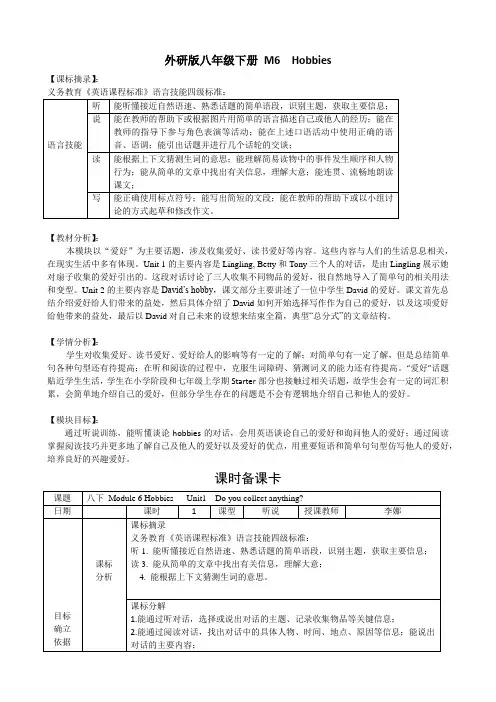
外研版八年级下册M6 Hobbies【课标摘录】:义务教育《英语课程标准》语言技能四级标准:【教材分析】:本模块以“爱好”为主要话题,涉及收集爱好、读书爱好等内容。
这些内容与人们的生活息息相关,在现实生活中多有体现。
Unit 1的主要内容是Lingling, Betty和Tony三个人的对话,是由Lingling展示她对扇子收集的爱好引出的。
这段对话讨论了三人收集不同物品的爱好,很自然地导入了简单句的相关用法和变型。
Unit 2的主要内容是David’s hobby,课文部分主要讲述了一位中学生David的爱好。
课文首先总结介绍爱好给人们带来的益处,然后具体介绍了David如何开始选择写作作为自己的爱好,以及这项爱好给他带来的益处,最后以David对自己未来的设想来结束全篇,典型“总分式”的文章结构。
【学情分析】:学生对收集爱好、读书爱好、爱好给人的影响等有一定的了解;对简单句有一定了解,但是总结简单句各种句型还有待提高;在听和阅读的过程中,克服生词障碍、猜测词义的能力还有待提高。
“爱好”话题贴近学生生活,学生在小学阶段和七年级上学期Starter部分也接触过相关话题,故学生会有一定的词汇积累,会简单地介绍自己的爱好,但部分学生存在的问题是不会有逻辑地介绍自己和他人的爱好。
【模块目标】:通过听说训练,能听懂谈论hobbies的对话,会用英语谈论自己的爱好和询问他人的爱好;通过阅读掌握阅读技巧并更多地了解自己及他人的爱好以及爱好的优点,用重要短语和简单句句型仿写他人的爱好,培养良好的兴趣爱好。
课时备课卡1.What is the main idea of each paragraph?2.What’s the structure of this passage?。

仁爱版英语八年级下册整册教案Unit6 Enjoying CyclingTopic 1 We’re going on a spring field tripSection A说课稿一、说教材1. 教材分析仁爱版初中英语教材共六册,每册由四个模块组成,每个模块由单元-———话题————功能——-任务构成,编写思路清晰,符合学生的认识发展规律.八年级英语下册第六单元Topic1 Section A讲述了让学生学习如何用英语谈论旅游,并收集旅游信息。
它由3部分组成,用1课时完成。
通过学习Section A,学生可以更多的了解旅游知识并提高实际能力;动词不定式是本节课的重点语法项目。
2.教学目标(1).知识目标要求学生牢记Section A所有新学的四会单词.短语和重点句型;掌握不定式“to do"的用法。
(2).技能目标:能用英语与他人谈论关于旅游的话题。
培养学生提高语言交际能力,能在小组中积极与他人协作,从而开阔自己的视野,扩大知识面.(3).情感目标培养学生爱护大自然,热爱旅游.积极参与课堂上各种英语实践活动的兴趣.培养学生分工合作和团体协作精神.3.教学重点和难点(1)。
重点:谈论关于旅游的话题。
(2)。
重点和难点:不定式“to do”的用法。
二。
说学情1.学生对旅游较感兴趣,但对旅游知识了解较少.2。
学生的词汇量掌握不多.3. 学生平时较少用英语与他人交谈并表达信息..三。
说教法学法按照课程改革的要求,遵循“老师由主演变导演,学生由配角变主角”的角色转换,采用把课堂交给学生的教学理论,我运用自由讨论。
分组工作.结对练习。
问答练习等方法,借助多媒体、录音机,图片等教学手段,设置特定的语言环境,使学生在轻松愉快的气氛中理解.运用英语。
四.说教学程序我设计了以下的步骤来训练学生的听.说。
读。
写的能力,尤其是他们“说”的能力。
(一)温故知新(1).请两位学生用上节课重点句型号,分别复述Unit 5 Topic3 Section D 1a(2).教师与学生之间进行问答对话,让学生谈论关于他们最喜爱的旅游方式.设计意图:巩固上节课学过的知识,为学习新课铺垫.(二)情景导入用多媒体展示一些关于旅游和交通的图片,来引起学生的兴趣,并由此教学本节课的新单词,如:field ,trip ,cycle ,vehicle ,airline等。
仁爱英语八年级下Unit 6 Topic 2 Section B教案设计石柱中学谭红梅一、教案背景1、面向学生:中学2、学科:英语3、课时:14、版本:仁爱英语湘教版八年级下5、学生课前准备:①、预习仁爱英语八年级下Unit 6 Topic 2 section B 中的单词,弄清单词的读音和拼写。
②、自学课文,完成课后的练习。
③、让学生提出自学中遇到的问题。
④、在百度网搜索:了解明十三陵的相关知识。
二、教学课题:How about exploring the Ming Tombs?三、教材分析本节教材选自仁爱英语湘教版八年级下Unit 6 Topic 2 Section B 1a 。
本节内容主要通过谈论旅游的话题,使学生掌握情景交际的语言材料,进一步学习动词不定式的用法。
本节内容从旅游入手,贴近生活,有利于激发学生的学习兴趣,便于他们进一步了解我国的历史,从而激发他们的爱国热情和学习积极性,为后面的教学打下了基础。
教学目标:1.知识目标:A. 通过学习,学生能听懂有关旅游的短文或对话,能从中获取信息。
B. 学生能掌握本课的单词和语言点的用法,80%的学生能熟练运用。
2. 技能目标:培养学生通过看视频和动画熟练运用交际用语的能力,能够运用所学知识自己创设情境表达自己的意愿。
同时通过对话的学习,培养学生的听、说、读、写能力,从而实现用英语进行交际的目的。
3. 情感目标:通过学习,使学生进一步了解我国的历史,培养学生的爱国主义情操,激发他们热爱大自然、热爱祖国的大好河山,勇于探索大自然奥秘的热情。
教学重难点:课文中语言点的用法:They surveyed the area to make sure their tombs faced south and had mountains behind them.Could you tell me something about the Ming Tombs?at the foot of 、in the northwest of Beijingspread out、on both sides ofIt’s about two and a half hours by bike.教学之前用百度在网上搜索明十三陵的相关教学材料,找了很多教案和材料作参考,了解到教学的重点和难点,确定课堂教学形式和方法。
Unit6 Topic1 SectionA 参考教案Ⅰ. Material analysis本节课为该话题的第一节课,建议用1课时上完。
主要活动为SectionA的1a和3。
本单元教学内容主要围绕旅游和交通方面的话题展开。
话题一主要让学生学习如何用英语谈论旅游,如何用英语预订车票、房间,如何为旅游筹集资金、制订出行计划等。
动词不定式是本话题的重点语法项目。
本课通过让学生掌握旅游地点、交通方式和所需费用等常识,掌握黑体单词和短语field, proper,total, go on a visit to …和decide on…, 理解白体词汇mount, vehicle, airline, partner和suitable, 掌握动词不定式的用法,同时教育学生要学会制订计划;培养学生热爱旅游、积极探索的态度。
Ⅱ. Teaching aimsKnowledge aims:1. 学生能正确拼读并运用黑体单词。
2. 学生能正确运用以下短语造句:go on a visit to …, make a decision, too…to…和decide on…1/ 1213. 学生能自如地运用以下句式进行交流:I have some exciting news to tell you.We’re going on a three-day visit to Mount Tai.It will take us a few days to get there by bike.It costs …Let’s decide.We’ll decide on the best way to travel on our field trip. 4. 学生能简单地掌握动词不定式的用法。
Skill aims:1. 能听懂有关旅游的短文或对话,并从中获取信息。
2. 能使用英语与他人谈论关于旅游的话题。
3. 能理解有关旅游、预订等方面的叙述,并从中获取需要的信息。
第6单元课题Unit 6 An ol d man tried to move the mountains.Section B (1)课时安排共(5)课时课程标准P15.(1)能听懂学习活动中连续的指令和问题,并做出适当的反应。
(2)能参照范例写出或回复简单的问候和邀请。
学习目标1.通过图片展示及情境创设,4/5的学生能准确辨识单词。
2.通过听听力1-3遍,2/3的学生能听懂听力材料大意并准确完成1c及1d的练习。
3.通过小组讨论,2/3的学生明白中国传统文化的博大、精深,并吸取中国传统文化中的精华。
教学重点1) 学会本课时出现的生词及用法。
2) 进行听力训练,提高综合听说能力。
3)阅读短文,获得相关信息,提高学生们的综合阅读能力。
教学难点1. 听力训练2. 阅读2b部分的短文并完成相关要求。
教学方法小组合作,情景创设教学准备彩色粉笔,ppt课前作业回顾本单元所学的如何提供建议的句型。
教学过程教学环节课堂合作交流二次备课(修改人:)环节一Step 1 ReviewLet some Ss talk something about the Monkey King.Step 2 Warm up1. T: Show one picture of the story The Emperor’s New Clothes.2. Ask some questions about it.e.g.1. Look at the picture. Do you know this story?What’s the name of this story?S1: The Emperor’s New Clothes.课中作业1a环节二Step 3 Presentation1. Present the new words on the big screen and learn the new words together.2. Ss read and try to remember the new words.silk emperor underwear gold stupid cheatStep 4 MatchingWork on 1a1. Ask one student read words in 1a. Tell Ss to match the words with the letters in the pictures in 1b.2. Let some Ss tell their answers. Then check together.3. Try to remember the new words.课中作业1b,1c,1d环节三Step 5 ListeningWork on 1b:1. Tell Ss to look at the p ictures in 1c. Tell them these are the pictures from the story: The Emperor’s New Clothes. Listen to the tapes and number the pictures.2. Play the recording for the Ss. Ss just listen for the first time. Play the recording again and number the pictures.3. Check the answers:Work on 1c:1. Let Ss read the sentences in 1c first. Tell Ss to listen againand fill in the blanks with the right words.2. Play the recording again for the Ss to listen and write the words.3. Ss listen to the recording carefully and try to write the right words.3. Check t he answers with the class.Keys: clothes, brothers, give, kept, looked, saw, shouted, wearing课中作业:Exercise:Listen and try to answer the questions?1. What’s the name of the story?2. Is it a traditional Chinese story?3. What’s the emperor’s hobby?4. Why were the new clothes special?5. How do we know that the two brothers were really trying to cheat the emperor?6. Why didn’t everyone say that the new clothes were really nice?7. Who said that the emperor wasn’t wearing any clothes? Keys: 1. It’s The Emperor’s New Clothes.2. No, it isn’t. It’s from Europe.3. He liked new clothes. He loved buying and looking at his new clothes.4. Because people couldn’t see the new clothes unless they were clever.5. Because they kept all the gold and silk for themselves.6. Because they didn’t want other people to know that th ey were stupid.7. A young boy.Listen and try to answer the questions?1. What’s the name of the story?2. Is it a traditional Chinese story?3. What’s the emperor’s hobby?4. Why were the new clothes special?环节四Step 6 Telling the story1. Work in groups. Tell the story of The Emperor’s New Clothes. Use the information in 1c and 1d.2. Let some groups tell the story to the class.课后作业设计:1. Read the article again after school.2. Write a short passage about Cathy’s daily life and h er opinionsabout the ed ucation of the kids.(修改人:)板书设计:Unit 6 An old man tried to move the mountains.Section B (1)1.as soon as :She was ____ busy _____ she had no time to make a dress for the party.2.So... that: The mice knew that _____ they helped her make a dress, she would not be able togo to the party.3. unless:___________ the prince saw her, he fell in love with her.4.silk emperor underwear gold stupid cheat2. We thought you were never coming back. 我以为你们再也回不来了。
初中英语Go For It! 教材八年级(下)Unit 6的教学设计一、教学内容分析本课时的内容是以慈善活动“滑冰马拉松”的新闻报道为主题,通过以读促说的教学目的展开话题。
二、教学目标1、语言目标词汇:skater raise several句型:How long have you been doing something?I have been doing something for/since….When did you start doing something?2、情感目标通过阅读使学生树立和加强积极参加慈善活动的意识,了解马拉松作为慈善活动之一的文化内涵。
3、能力目标以读促说,培养学生的读说能力。
通过对以滑冰马拉松这一慈善题材的阅读,促进学生在一定的语境中运用现在完成进行时和一般过去时进行语言的输出和交流。
阅读中渗透阅读策略,培养学生分析问题、解决问题的能力。
三、教学重、难点1、在特定的语境中正确运用现在完成进行时和一般过去时进行语言交流。
2、对发生的事情进行现场报道。
四、教学方法任务型教学法,情景教学法,交际法。
五、教学步骤------------------------------WorkSheet--------------------------A. It’s 2 pm. Read the passage and plete the following table.B.GroupworkDo a survey about what charity activities your classmates take part in.1.Show your survey.2.Give a news report.I’m talking to you from HuandongSchool. Here,students are making a survey….In m y group,...Thank you for joining us.课后反思遵循原则,解读文本,渗透策略,培养以读促说能力---2010省初中英语阅读教学展示与研讨活动有感这次有幸参加了某某省初中英语阅读教学展示与研讨活动,并亲自承担了展示课的任务。
Unit6 A charity walk三.列出重要的短语,查资料解释其用法.1. raise money for …2. group oneself into a team of 4 6. start training 8. team spirit9. within 48 hours 10. at least11. walk over mountains 12. keep you fortable13. an excellent chance 15. try one’s best四.翻译下列句子。
1. Oxfam trailwalker has been one of Hong Kong’s biggestfund-raising events since 1981.2. Trailwalker is held in November every year.3. It is an excellent chance for people to learn team spirit. 4.It’s useful to have support teams to bring you food and drinks.5. It is necessary for them to support and help each other both before and during the event.6. It is necessary that you start training a few months before thewalk.五.预习课文之后,判断下列句子正误。
1. Oxfam Trailwalker is one of the biggest fund-raising events inHong Kong. ()2. All the people can join in it.()3. There are four people in each group inthe charity walk.()4. It’s necessary to carry everything with you.()5. Each team must raise at least HK $650.()六.练习朗读Reading 课文,并把课文分成三部分。
Unit6An old man tried to move the mountains.第一课时Section A(1a2d)【学习目标】1.重点单词:shoot,begin,god,remind,bit,silly2.重点短语:Journey to the West,Yu Gong Moves a Mountain,Hou Yi shoots the Suns,Nu Wa Repairs the Sky,once upon a time,instead of,work on,a little bit3.重点句式:An old man tried to move the mountains.How does the story begin?Where would they put all the earth and stone from the mountains?As soon as the man finished talking,Yu Gong said that his family could continue to move the mountains after he died.Finally,a god was so moved by Yu Gong that he sent two gods to take the mountains away.It doesn't seem very possible to move a mountain.The story is trying to show us that anything is possible if you work hard.Yu Gong kept trying and didn't give up.I think we should try to find other ways to solve a problem.What could Yu Gong do instead of moving the mountains?That's better and faster than moving a mountain!You have different opinions about the story,and neither of you are wrong.There are many sides to a story and many ways to understand it.【学习重点】1.重点短语和句型2.unless,so...that,as soon as...等的用法【学习难点】1.重点短语和句型2.unless,so...that,as soon as...等的用法【自学学习】一、预习课本P4142新单词并背诵,完成下面的汉译英。